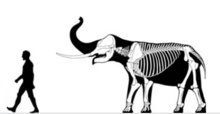Sinomastodon
|
Sinomastodon Temporal range: Late Miocene–Early Pleistocene |
|
|---|---|
 |
|
| Skeletal restoration | |
| Scientific classification | |
| Kingdom: | Animalia |
| Phylum: | Chordata |
| Class: | Mammalia |
| Order: | Proboscidea |
| Family: | †Gomphotheriidae |
| Genus: |
†Sinomastodon Tobien et al., 1986 |
| Species | |
|
|
Sinomastodon ("Chinese mastodont") is an extinct gomphothere genus (of order Proboscidea), from the Late Miocene to the Early deposits of south-east Asia (China, Japan, and Indonesia). It is not to be confused with the genus Mammut from a different proboscidean family, whose members are commonly called "mastodons".
The animal was very similar to modern elephants with size ranging from 3.6 to 5.3 m. Several species are known from China, the best known being S. hanjiangensis from the Late Miocene and Early Pliocene of the Shanxi province. It is known from an incomplete skeleton of an adult (measuring 5.3 m) including maxilla, mandibles, teeth, tusks and other materials have been discovered. The Japanese species S. sendaicus described in 1924 from dentary materials from Pliocene deposits has been ascribed to the genus, as well as the species S. bumiajuensis (formerly Tetralophodon) from the late Pliocene of Java. One individual of S. hanjiangensis was a 30 year-old 2.07 metres (6.8 ft) tall and weighed 2.1 tonnes (2.1 long tons; 2.3 short tons).
...
Wikipedia
